MITS5505 Knowledge Management Report: Commitment and Transfer
VerifiedAdded on 2023/01/05
|7
|1964
|77
Report
AI Summary
This report analyzes the relationship between knowledge transfer, organisational commitment, and knowledge management maturity, drawing on a study conducted at a Brazilian university. The research, which employed both descriptive and quantitative methods, involved administrative technicia...
Read More
Contribute Materials
Your contribution can guide someone’s learning journey. Share your
documents today.
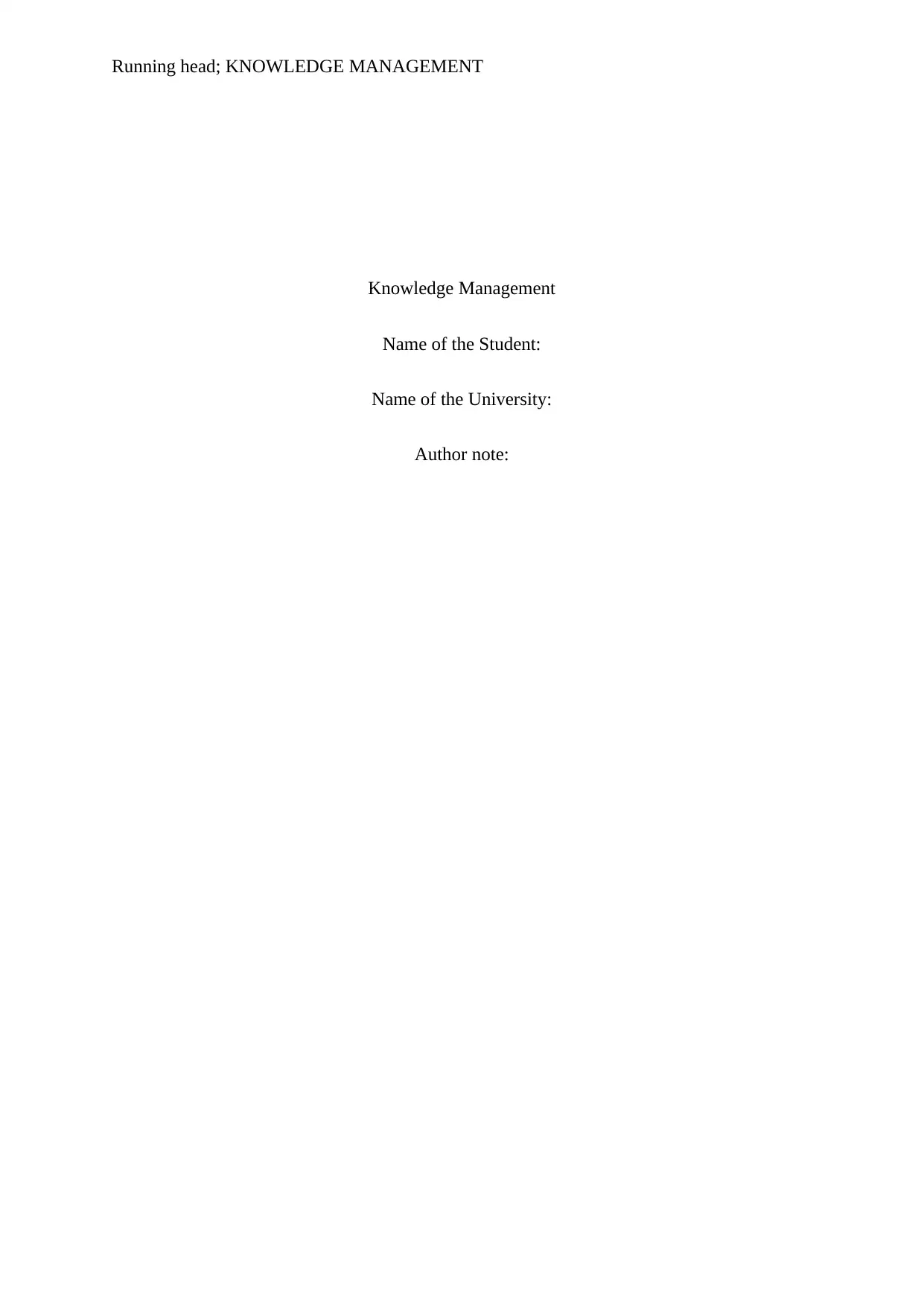
Running head; KNOWLEDGE MANAGEMENT
Knowledge Management
Name of the Student:
Name of the University:
Author note:
Knowledge Management
Name of the Student:
Name of the University:
Author note:
Secure Best Marks with AI Grader
Need help grading? Try our AI Grader for instant feedback on your assignments.
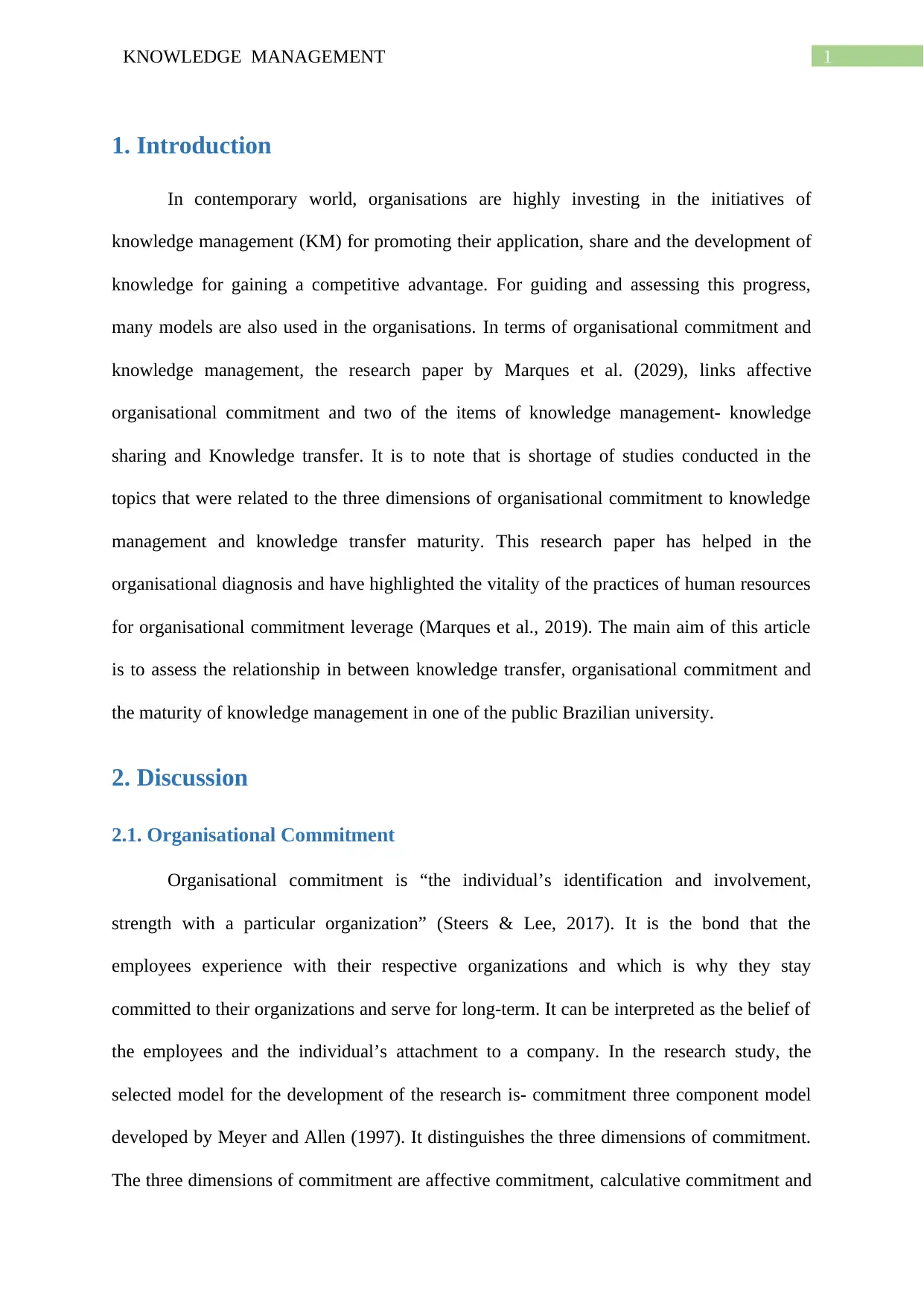
1KNOWLEDGE MANAGEMENT
1. Introduction
In contemporary world, organisations are highly investing in the initiatives of
knowledge management (KM) for promoting their application, share and the development of
knowledge for gaining a competitive advantage. For guiding and assessing this progress,
many models are also used in the organisations. In terms of organisational commitment and
knowledge management, the research paper by Marques et al. (2029), links affective
organisational commitment and two of the items of knowledge management- knowledge
sharing and Knowledge transfer. It is to note that is shortage of studies conducted in the
topics that were related to the three dimensions of organisational commitment to knowledge
management and knowledge transfer maturity. This research paper has helped in the
organisational diagnosis and have highlighted the vitality of the practices of human resources
for organisational commitment leverage (Marques et al., 2019). The main aim of this article
is to assess the relationship in between knowledge transfer, organisational commitment and
the maturity of knowledge management in one of the public Brazilian university.
2. Discussion
2.1. Organisational Commitment
Organisational commitment is “the individual’s identification and involvement,
strength with a particular organization” (Steers & Lee, 2017). It is the bond that the
employees experience with their respective organizations and which is why they stay
committed to their organizations and serve for long-term. It can be interpreted as the belief of
the employees and the individual’s attachment to a company. In the research study, the
selected model for the development of the research is- commitment three component model
developed by Meyer and Allen (1997). It distinguishes the three dimensions of commitment.
The three dimensions of commitment are affective commitment, calculative commitment and
1. Introduction
In contemporary world, organisations are highly investing in the initiatives of
knowledge management (KM) for promoting their application, share and the development of
knowledge for gaining a competitive advantage. For guiding and assessing this progress,
many models are also used in the organisations. In terms of organisational commitment and
knowledge management, the research paper by Marques et al. (2029), links affective
organisational commitment and two of the items of knowledge management- knowledge
sharing and Knowledge transfer. It is to note that is shortage of studies conducted in the
topics that were related to the three dimensions of organisational commitment to knowledge
management and knowledge transfer maturity. This research paper has helped in the
organisational diagnosis and have highlighted the vitality of the practices of human resources
for organisational commitment leverage (Marques et al., 2019). The main aim of this article
is to assess the relationship in between knowledge transfer, organisational commitment and
the maturity of knowledge management in one of the public Brazilian university.
2. Discussion
2.1. Organisational Commitment
Organisational commitment is “the individual’s identification and involvement,
strength with a particular organization” (Steers & Lee, 2017). It is the bond that the
employees experience with their respective organizations and which is why they stay
committed to their organizations and serve for long-term. It can be interpreted as the belief of
the employees and the individual’s attachment to a company. In the research study, the
selected model for the development of the research is- commitment three component model
developed by Meyer and Allen (1997). It distinguishes the three dimensions of commitment.
The three dimensions of commitment are affective commitment, calculative commitment and
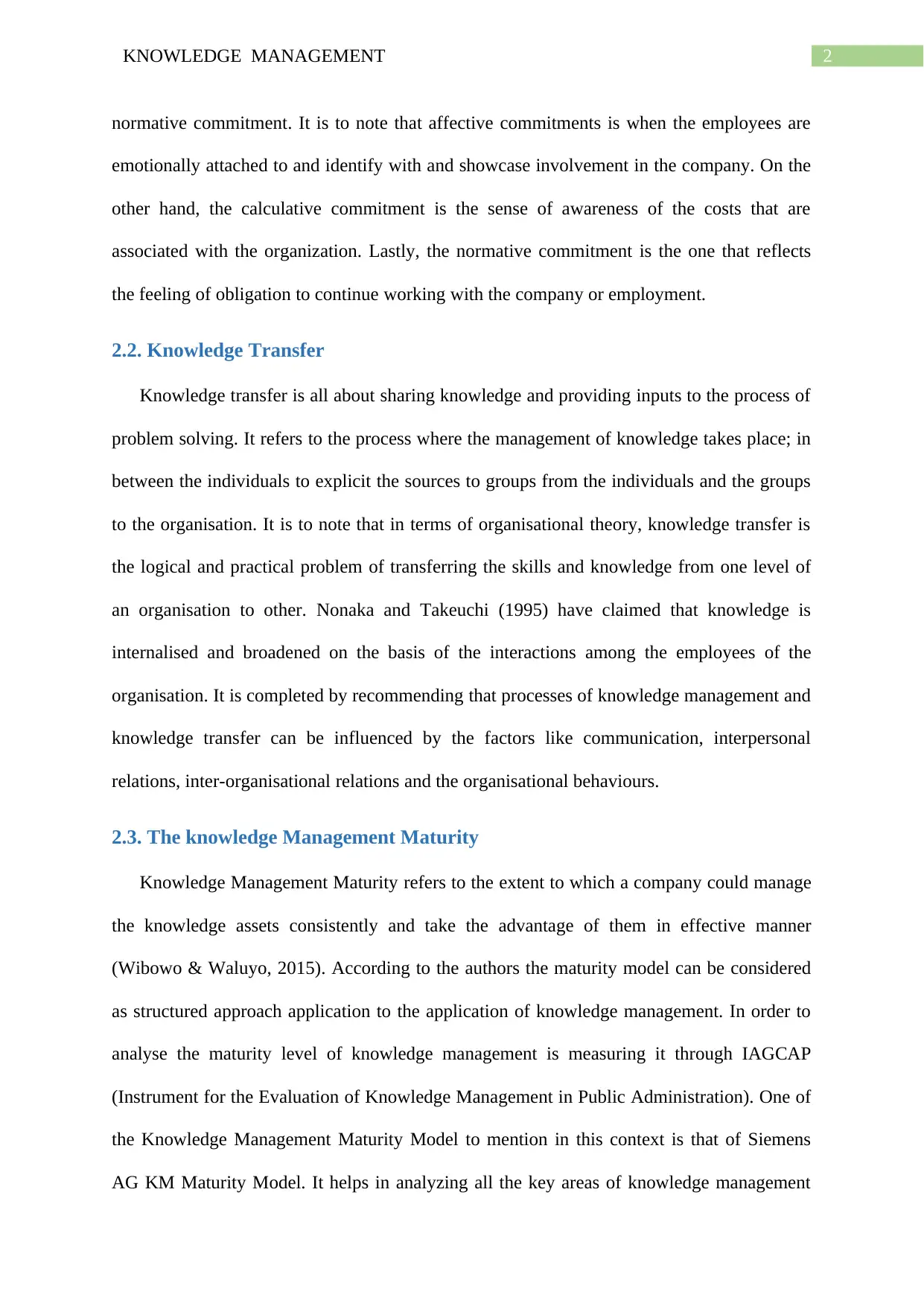
2KNOWLEDGE MANAGEMENT
normative commitment. It is to note that affective commitments is when the employees are
emotionally attached to and identify with and showcase involvement in the company. On the
other hand, the calculative commitment is the sense of awareness of the costs that are
associated with the organization. Lastly, the normative commitment is the one that reflects
the feeling of obligation to continue working with the company or employment.
2.2. Knowledge Transfer
Knowledge transfer is all about sharing knowledge and providing inputs to the process of
problem solving. It refers to the process where the management of knowledge takes place; in
between the individuals to explicit the sources to groups from the individuals and the groups
to the organisation. It is to note that in terms of organisational theory, knowledge transfer is
the logical and practical problem of transferring the skills and knowledge from one level of
an organisation to other. Nonaka and Takeuchi (1995) have claimed that knowledge is
internalised and broadened on the basis of the interactions among the employees of the
organisation. It is completed by recommending that processes of knowledge management and
knowledge transfer can be influenced by the factors like communication, interpersonal
relations, inter-organisational relations and the organisational behaviours.
2.3. The knowledge Management Maturity
Knowledge Management Maturity refers to the extent to which a company could manage
the knowledge assets consistently and take the advantage of them in effective manner
(Wibowo & Waluyo, 2015). According to the authors the maturity model can be considered
as structured approach application to the application of knowledge management. In order to
analyse the maturity level of knowledge management is measuring it through IAGCAP
(Instrument for the Evaluation of Knowledge Management in Public Administration). One of
the Knowledge Management Maturity Model to mention in this context is that of Siemens
AG KM Maturity Model. It helps in analyzing all the key areas of knowledge management
normative commitment. It is to note that affective commitments is when the employees are
emotionally attached to and identify with and showcase involvement in the company. On the
other hand, the calculative commitment is the sense of awareness of the costs that are
associated with the organization. Lastly, the normative commitment is the one that reflects
the feeling of obligation to continue working with the company or employment.
2.2. Knowledge Transfer
Knowledge transfer is all about sharing knowledge and providing inputs to the process of
problem solving. It refers to the process where the management of knowledge takes place; in
between the individuals to explicit the sources to groups from the individuals and the groups
to the organisation. It is to note that in terms of organisational theory, knowledge transfer is
the logical and practical problem of transferring the skills and knowledge from one level of
an organisation to other. Nonaka and Takeuchi (1995) have claimed that knowledge is
internalised and broadened on the basis of the interactions among the employees of the
organisation. It is completed by recommending that processes of knowledge management and
knowledge transfer can be influenced by the factors like communication, interpersonal
relations, inter-organisational relations and the organisational behaviours.
2.3. The knowledge Management Maturity
Knowledge Management Maturity refers to the extent to which a company could manage
the knowledge assets consistently and take the advantage of them in effective manner
(Wibowo & Waluyo, 2015). According to the authors the maturity model can be considered
as structured approach application to the application of knowledge management. In order to
analyse the maturity level of knowledge management is measuring it through IAGCAP
(Instrument for the Evaluation of Knowledge Management in Public Administration). One of
the Knowledge Management Maturity Model to mention in this context is that of Siemens
AG KM Maturity Model. It helps in analyzing all the key areas of knowledge management
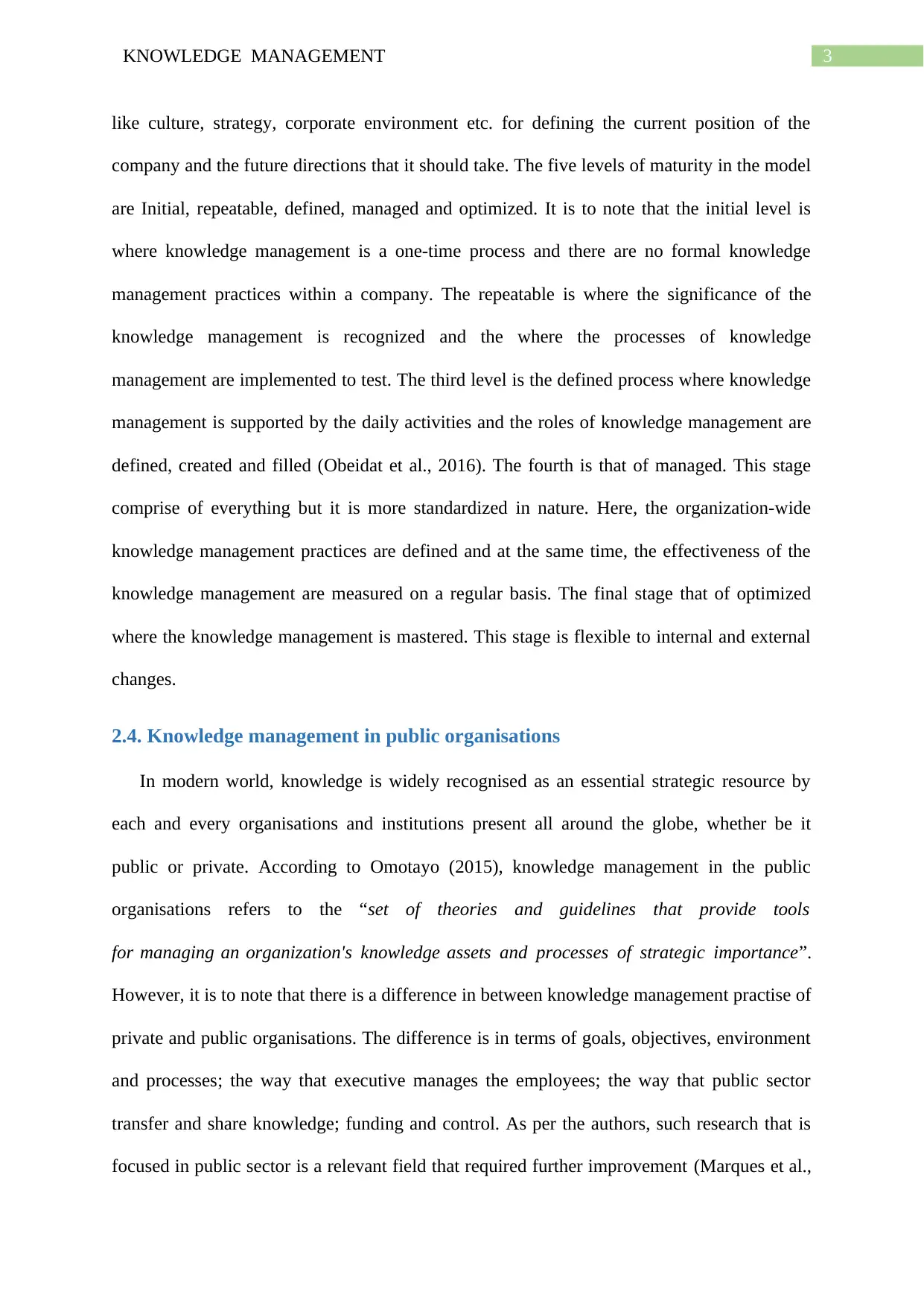
3KNOWLEDGE MANAGEMENT
like culture, strategy, corporate environment etc. for defining the current position of the
company and the future directions that it should take. The five levels of maturity in the model
are Initial, repeatable, defined, managed and optimized. It is to note that the initial level is
where knowledge management is a one-time process and there are no formal knowledge
management practices within a company. The repeatable is where the significance of the
knowledge management is recognized and the where the processes of knowledge
management are implemented to test. The third level is the defined process where knowledge
management is supported by the daily activities and the roles of knowledge management are
defined, created and filled (Obeidat et al., 2016). The fourth is that of managed. This stage
comprise of everything but it is more standardized in nature. Here, the organization-wide
knowledge management practices are defined and at the same time, the effectiveness of the
knowledge management are measured on a regular basis. The final stage that of optimized
where the knowledge management is mastered. This stage is flexible to internal and external
changes.
2.4. Knowledge management in public organisations
In modern world, knowledge is widely recognised as an essential strategic resource by
each and every organisations and institutions present all around the globe, whether be it
public or private. According to Omotayo (2015), knowledge management in the public
organisations refers to the “set of theories and guidelines that provide tools
for managing an organization's knowledge assets and processes of strategic importance”.
However, it is to note that there is a difference in between knowledge management practise of
private and public organisations. The difference is in terms of goals, objectives, environment
and processes; the way that executive manages the employees; the way that public sector
transfer and share knowledge; funding and control. As per the authors, such research that is
focused in public sector is a relevant field that required further improvement (Marques et al.,
like culture, strategy, corporate environment etc. for defining the current position of the
company and the future directions that it should take. The five levels of maturity in the model
are Initial, repeatable, defined, managed and optimized. It is to note that the initial level is
where knowledge management is a one-time process and there are no formal knowledge
management practices within a company. The repeatable is where the significance of the
knowledge management is recognized and the where the processes of knowledge
management are implemented to test. The third level is the defined process where knowledge
management is supported by the daily activities and the roles of knowledge management are
defined, created and filled (Obeidat et al., 2016). The fourth is that of managed. This stage
comprise of everything but it is more standardized in nature. Here, the organization-wide
knowledge management practices are defined and at the same time, the effectiveness of the
knowledge management are measured on a regular basis. The final stage that of optimized
where the knowledge management is mastered. This stage is flexible to internal and external
changes.
2.4. Knowledge management in public organisations
In modern world, knowledge is widely recognised as an essential strategic resource by
each and every organisations and institutions present all around the globe, whether be it
public or private. According to Omotayo (2015), knowledge management in the public
organisations refers to the “set of theories and guidelines that provide tools
for managing an organization's knowledge assets and processes of strategic importance”.
However, it is to note that there is a difference in between knowledge management practise of
private and public organisations. The difference is in terms of goals, objectives, environment
and processes; the way that executive manages the employees; the way that public sector
transfer and share knowledge; funding and control. As per the authors, such research that is
focused in public sector is a relevant field that required further improvement (Marques et al.,
Secure Best Marks with AI Grader
Need help grading? Try our AI Grader for instant feedback on your assignments.
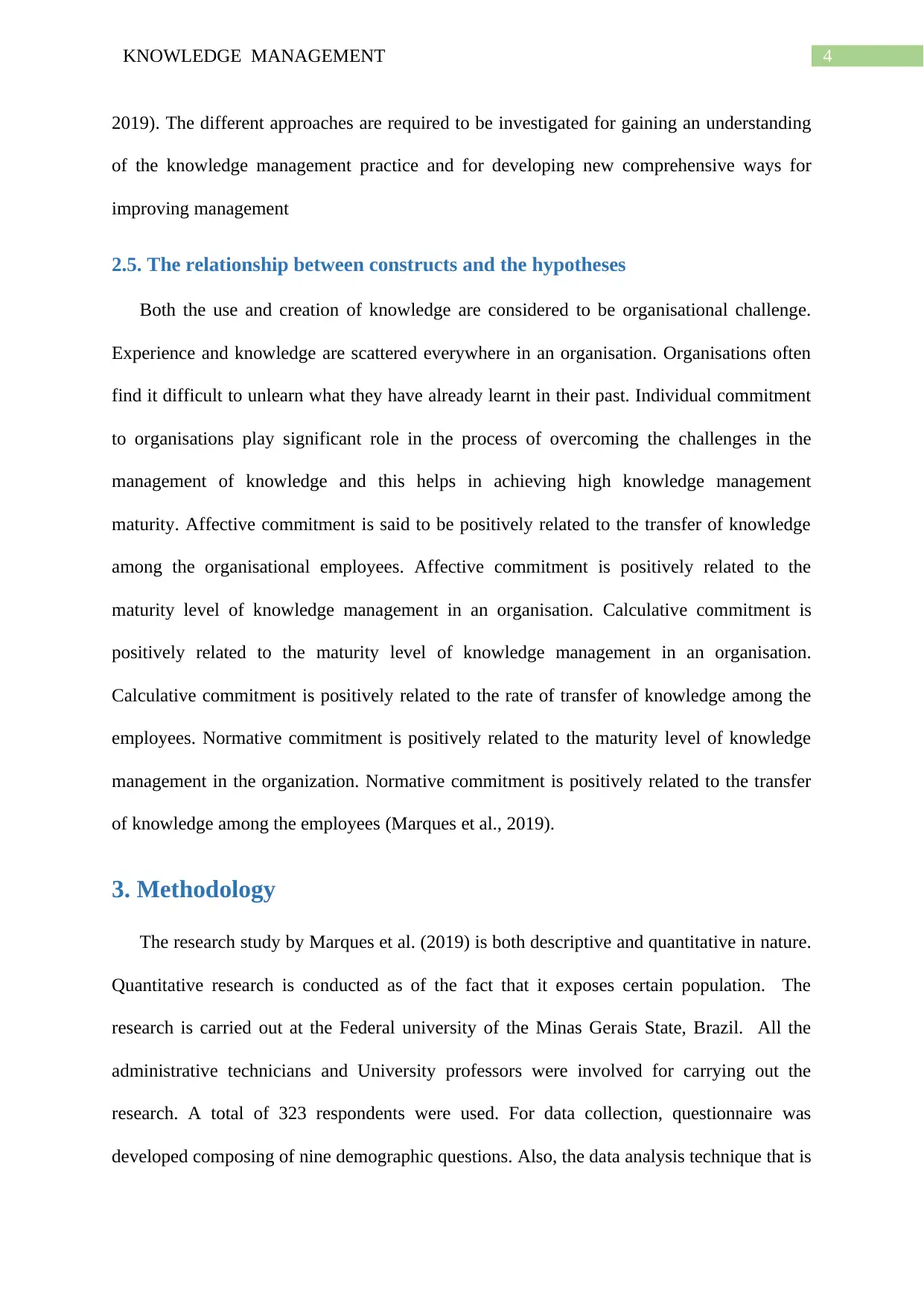
4KNOWLEDGE MANAGEMENT
2019). The different approaches are required to be investigated for gaining an understanding
of the knowledge management practice and for developing new comprehensive ways for
improving management
2.5. The relationship between constructs and the hypotheses
Both the use and creation of knowledge are considered to be organisational challenge.
Experience and knowledge are scattered everywhere in an organisation. Organisations often
find it difficult to unlearn what they have already learnt in their past. Individual commitment
to organisations play significant role in the process of overcoming the challenges in the
management of knowledge and this helps in achieving high knowledge management
maturity. Affective commitment is said to be positively related to the transfer of knowledge
among the organisational employees. Affective commitment is positively related to the
maturity level of knowledge management in an organisation. Calculative commitment is
positively related to the maturity level of knowledge management in an organisation.
Calculative commitment is positively related to the rate of transfer of knowledge among the
employees. Normative commitment is positively related to the maturity level of knowledge
management in the organization. Normative commitment is positively related to the transfer
of knowledge among the employees (Marques et al., 2019).
3. Methodology
The research study by Marques et al. (2019) is both descriptive and quantitative in nature.
Quantitative research is conducted as of the fact that it exposes certain population. The
research is carried out at the Federal university of the Minas Gerais State, Brazil. All the
administrative technicians and University professors were involved for carrying out the
research. A total of 323 respondents were used. For data collection, questionnaire was
developed composing of nine demographic questions. Also, the data analysis technique that is
2019). The different approaches are required to be investigated for gaining an understanding
of the knowledge management practice and for developing new comprehensive ways for
improving management
2.5. The relationship between constructs and the hypotheses
Both the use and creation of knowledge are considered to be organisational challenge.
Experience and knowledge are scattered everywhere in an organisation. Organisations often
find it difficult to unlearn what they have already learnt in their past. Individual commitment
to organisations play significant role in the process of overcoming the challenges in the
management of knowledge and this helps in achieving high knowledge management
maturity. Affective commitment is said to be positively related to the transfer of knowledge
among the organisational employees. Affective commitment is positively related to the
maturity level of knowledge management in an organisation. Calculative commitment is
positively related to the maturity level of knowledge management in an organisation.
Calculative commitment is positively related to the rate of transfer of knowledge among the
employees. Normative commitment is positively related to the maturity level of knowledge
management in the organization. Normative commitment is positively related to the transfer
of knowledge among the employees (Marques et al., 2019).
3. Methodology
The research study by Marques et al. (2019) is both descriptive and quantitative in nature.
Quantitative research is conducted as of the fact that it exposes certain population. The
research is carried out at the Federal university of the Minas Gerais State, Brazil. All the
administrative technicians and University professors were involved for carrying out the
research. A total of 323 respondents were used. For data collection, questionnaire was
developed composing of nine demographic questions. Also, the data analysis technique that is
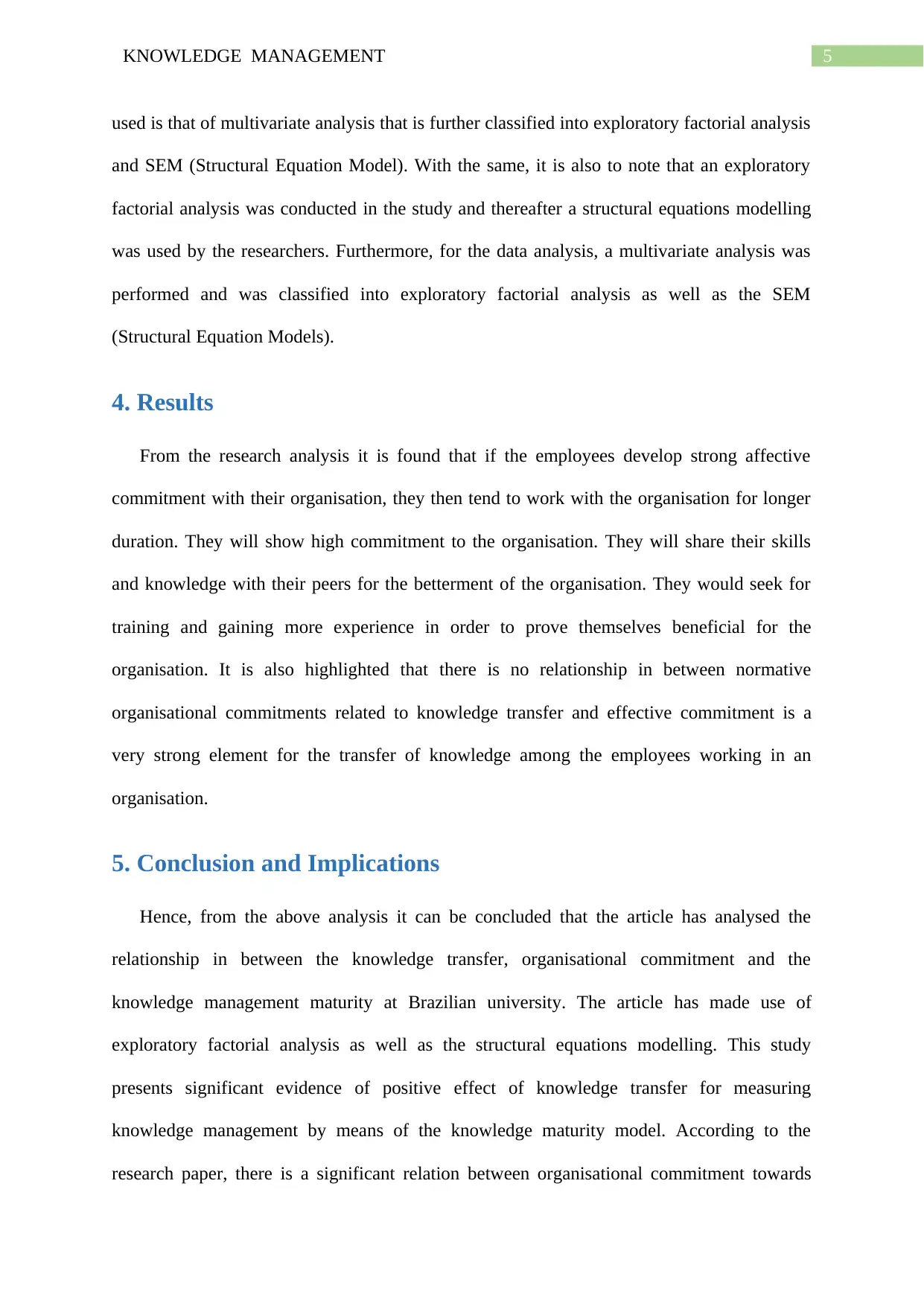
5KNOWLEDGE MANAGEMENT
used is that of multivariate analysis that is further classified into exploratory factorial analysis
and SEM (Structural Equation Model). With the same, it is also to note that an exploratory
factorial analysis was conducted in the study and thereafter a structural equations modelling
was used by the researchers. Furthermore, for the data analysis, a multivariate analysis was
performed and was classified into exploratory factorial analysis as well as the SEM
(Structural Equation Models).
4. Results
From the research analysis it is found that if the employees develop strong affective
commitment with their organisation, they then tend to work with the organisation for longer
duration. They will show high commitment to the organisation. They will share their skills
and knowledge with their peers for the betterment of the organisation. They would seek for
training and gaining more experience in order to prove themselves beneficial for the
organisation. It is also highlighted that there is no relationship in between normative
organisational commitments related to knowledge transfer and effective commitment is a
very strong element for the transfer of knowledge among the employees working in an
organisation.
5. Conclusion and Implications
Hence, from the above analysis it can be concluded that the article has analysed the
relationship in between the knowledge transfer, organisational commitment and the
knowledge management maturity at Brazilian university. The article has made use of
exploratory factorial analysis as well as the structural equations modelling. This study
presents significant evidence of positive effect of knowledge transfer for measuring
knowledge management by means of the knowledge maturity model. According to the
research paper, there is a significant relation between organisational commitment towards
used is that of multivariate analysis that is further classified into exploratory factorial analysis
and SEM (Structural Equation Model). With the same, it is also to note that an exploratory
factorial analysis was conducted in the study and thereafter a structural equations modelling
was used by the researchers. Furthermore, for the data analysis, a multivariate analysis was
performed and was classified into exploratory factorial analysis as well as the SEM
(Structural Equation Models).
4. Results
From the research analysis it is found that if the employees develop strong affective
commitment with their organisation, they then tend to work with the organisation for longer
duration. They will show high commitment to the organisation. They will share their skills
and knowledge with their peers for the betterment of the organisation. They would seek for
training and gaining more experience in order to prove themselves beneficial for the
organisation. It is also highlighted that there is no relationship in between normative
organisational commitments related to knowledge transfer and effective commitment is a
very strong element for the transfer of knowledge among the employees working in an
organisation.
5. Conclusion and Implications
Hence, from the above analysis it can be concluded that the article has analysed the
relationship in between the knowledge transfer, organisational commitment and the
knowledge management maturity at Brazilian university. The article has made use of
exploratory factorial analysis as well as the structural equations modelling. This study
presents significant evidence of positive effect of knowledge transfer for measuring
knowledge management by means of the knowledge maturity model. According to the
research paper, there is a significant relation between organisational commitment towards

6KNOWLEDGE MANAGEMENT
knowledge transfer and the knowledge management maturity. Also, there is no relationship in
between normative organisational commitments related to knowledge transfer.
References:
Marques, J. M. R., La Falce, J. L., Marques, F. M. F. R., De Muylder, C. F., & Silva, J. T. M.
(2019). The relationship between organizational commitment, knowledge transfer and
knowledge management maturity. Journal of Knowledge Management.
Meyer, J.P. and Allen, N.J.A. (1997), Commitment in the Workplace: Theory, research, and
Application, Sage, Thousand Oaks, CA
Nonaka, I. and Takeuchi, H. (1995), The Knowledge-creating Company: How Japanese
Companies Creates the Dynamics of Innovation, Oxford University Press, New York,
NY.
Obeidat, B. Y., Al-Suradi, M. M., Masa’deh, R. E., & Tarhini, A. (2016). The impact of
knowledge management on innovation: An empirical study on Jordanian consultancy
firms. Management Research Review, 39(10), 1214-1238.
Omotayo, F. O. (2015). Knowledge Management as an important tool in Organisational
Management: A Review of Literature. Library Philosophy and Practice, 1(2015), 1-
23.
Steers, R. M., & Lee, T. W. (2017). Facilitating effective performance appraisals: The role of
employee commitment and organizational climate. In Performance measurement and
theory (pp. 75-93). Routledge.
Wibowo, M. A., & Waluyo, R. (2015). Knowledge management maturity in construction
companies. Procedia Engineering, 125, 89-94.
knowledge transfer and the knowledge management maturity. Also, there is no relationship in
between normative organisational commitments related to knowledge transfer.
References:
Marques, J. M. R., La Falce, J. L., Marques, F. M. F. R., De Muylder, C. F., & Silva, J. T. M.
(2019). The relationship between organizational commitment, knowledge transfer and
knowledge management maturity. Journal of Knowledge Management.
Meyer, J.P. and Allen, N.J.A. (1997), Commitment in the Workplace: Theory, research, and
Application, Sage, Thousand Oaks, CA
Nonaka, I. and Takeuchi, H. (1995), The Knowledge-creating Company: How Japanese
Companies Creates the Dynamics of Innovation, Oxford University Press, New York,
NY.
Obeidat, B. Y., Al-Suradi, M. M., Masa’deh, R. E., & Tarhini, A. (2016). The impact of
knowledge management on innovation: An empirical study on Jordanian consultancy
firms. Management Research Review, 39(10), 1214-1238.
Omotayo, F. O. (2015). Knowledge Management as an important tool in Organisational
Management: A Review of Literature. Library Philosophy and Practice, 1(2015), 1-
23.
Steers, R. M., & Lee, T. W. (2017). Facilitating effective performance appraisals: The role of
employee commitment and organizational climate. In Performance measurement and
theory (pp. 75-93). Routledge.
Wibowo, M. A., & Waluyo, R. (2015). Knowledge management maturity in construction
companies. Procedia Engineering, 125, 89-94.
1 out of 7
Related Documents
Your All-in-One AI-Powered Toolkit for Academic Success.
+13062052269
info@desklib.com
Available 24*7 on WhatsApp / Email
![[object Object]](/_next/static/media/star-bottom.7253800d.svg)
Unlock your academic potential
© 2024 | Zucol Services PVT LTD | All rights reserved.





